路飛之VUE
---恢复内容开始---
内容详细:
1. vue init webpack luffy
2. 安装依赖:
cd luffy
npm install vuex --save 用于:多组件之间数据共享
npm install vue-cookies --save 用于:操作cookie
npm install axios --save 用于:发送ajax请求
3.创建路由
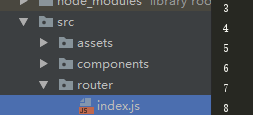
文件写在这里边
注意路由都写在 router:[ 写在这里 以逗号分隔 ]
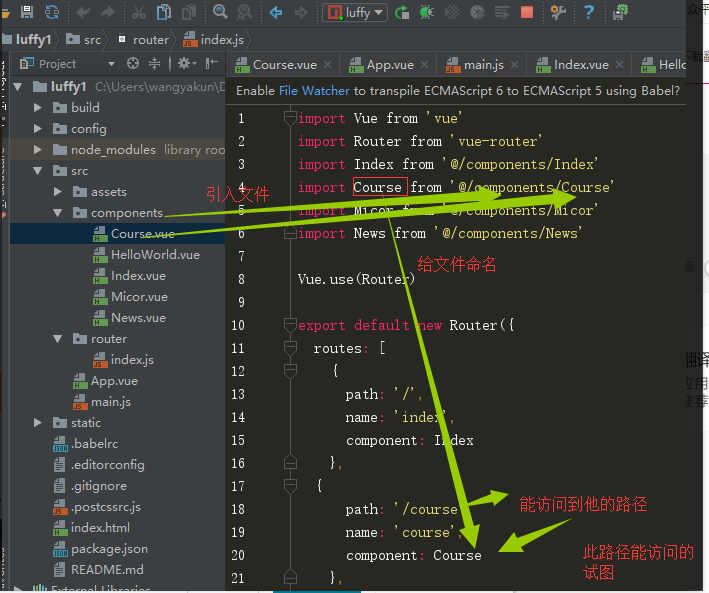

在 App.vue中的配置
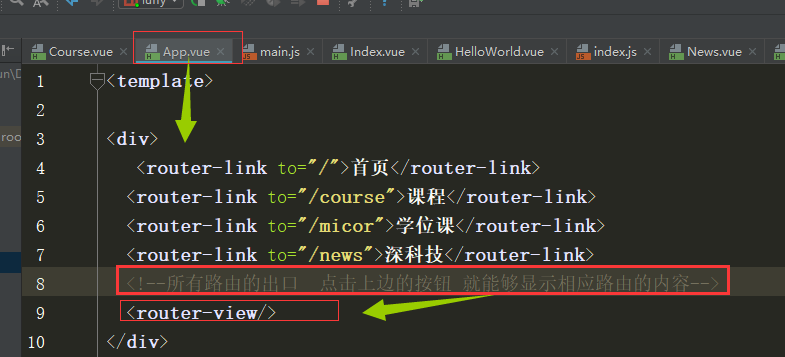
显示的页面效果
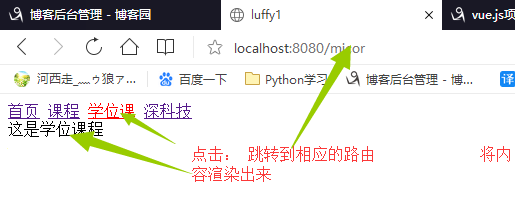
第二步:显示类表详情
用v-for 循环显示页面内容并且设置页面标签绑定的url 涉及到显示传过来的图片,每段文字绑定链接,在for循环中绑定链接 路由中接收id
<template> <div> <h4>{{msg}}</h4> <div v-for="item in courseList"> <!--第一种方式 有path:的形式来拼接路径--> <!--<router-link :to="{ path:'/detail/'+ item.id }">{{item.id}},{{item.name}}--> <!--<img class="img" v-bind:src="item.img" alt=""></router-link>--> <!--第二种方方式,用name 和params的方式来拼写链接 这里的to 需要绑定 详解请见下文--> <router-link :to="{ name:'detail',params:{id:item.id}}">{{item.id}},{{item.name}} <img class="img" v-bind:src="item.img" alt=""></router-link> <!--因为图片是从后端传送过来的,所以这里要写 v-bind:来绑定用户发送过来的数据 --> <router-link to="{name}"></router-link> </div> </div> </template> <script> export default { name: 'Course', data() { return { msg: '课程页面', #这里的逗号不能忘记 courseList:[] } },
//访问这个地址的时候,就会 mounted() { this.init() },
//这个函数的意思是要想执行后边的methods中的函数必须先执行它 而这个往往会调用methods中的函数 methods: { init() { this.courseList = [ // 用户发送的静态文件这里要在前边写上 require 这里注意写法 {id: 11, name: '21天学会Python', img: require('../assets/logo.png')}, {id: 21, name: '21天学会Java', img: require('../assets/logo.png')}, {id: 31, name: '21天学会Linux', img: require('../assets/logo.png')}, ] } } } </script> <!-- Add "scoped" attribute to limit CSS to this component only --> <style scoped> .img{width:50px;height:50px } </style>
路由在index.js文件中的写法
{ path: '/detail/:id ', name: 'detail', component: Detail },
////// 与上例中的router-link对比这计
<router-link :to="{ name:'detail',params:{id:item.id}}">{{item.id}},{{item.name}}
这个name就相当于上边的name 这里parmas中的的id的值就相当于上边的后边的 /:id
<img class="img" v-bind:src="item.img" alt=""></router-link>
效果
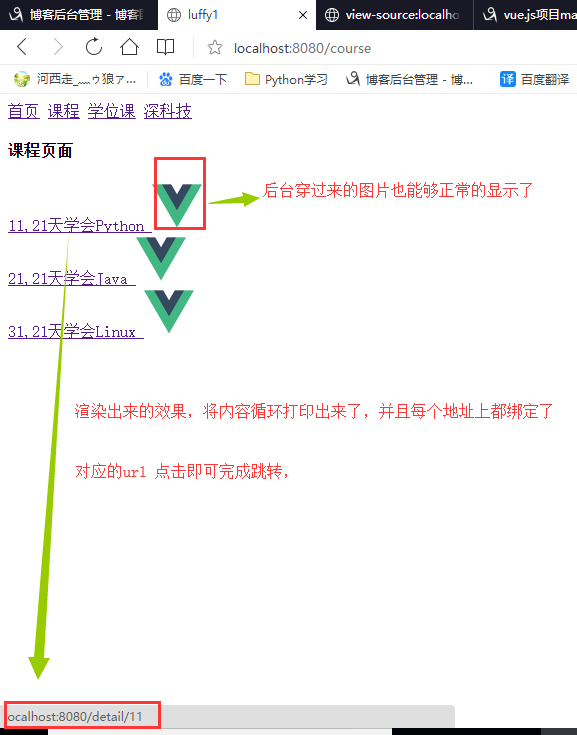
第三步:获取url中的id并显示相应的内容 显示课程推荐并可以点击显示推荐的内容
知识点:: 这里用到了主动给url 重定向 如何取出用户输入的url中的参数 params的值
<template> <div> <h4>{{msg}}{{currentCouersId}}</h4> <li>课程名称:{{CoureDtail.title}}</li> <li>课程简介:{{CoureDtail.summary}}</li> <h4>课程推荐</h4> <ul v-for="item in recoments"> <!--<li><router-link :to="{name:'detail',params:{id:item.id}}" >{{item.id}}{{item.name}}</router-link></li>-->
//点击触发下边定义好的事件,并将参数传给事件
<li @click="CourentChangeId(item.id)">{{item.id}}{{item.name}}</li> </ul> </div> </div> </template> <script> export default { name: 'Detail', data() { return { msg: '课程详细', //能够从url中去取出 自己在路由中定义的 名字为id的params(参数) 注意这里写的是route 用于显示课程推荐的的详情 currentCouersId:this.$route.params.id, CoureDtail: { title:'', summary:'' }, recoments:[ {id:100,name:'vue'}, {id:200,name:'sql'}, ] } }, mounted(){ this.init() }, methods:{ init(){ this.CoureDtail={ title:'21天学会python', summary:'休想', } }, CourentChangeId(id){ // 1 主动将课程内容根据课程id进行更新 this.currentCouersId=id // 2 再次执行一个init方法将数据刷新上去 this.init() // 注意这里写的是router 要与上边区分开来 // 重要 将url 进行重定向 相当于django中的 redirect this.$router.push({name:'detail',params:{id:id}}) } } } </script> <!-- Add "scoped" attribute to limit CSS to this component only --> <style scoped> </style>
第四部:登录
使用vuex组件来生成一个全局的store组件 这个全局的组件中有他的属性和方法, 所以 在任何一个组件中都可以进行调用
使用vue-cookies 组件来对用户登录的数据进行记录和查询
自己写的store组件 重要:
import Vue from 'vue'
import Vuex from 'vuex'
import Cookie from 'vue-cookies'
Vue.use(Vuex)
export default new Vuex.Store({
// 组件中通过 this.$store.state.username 调用 全局属性
state: {
username: Cookie.get('username'),
token: Cookie.get('token'),
//配置全局的api,当我组件中用到相关api 的使用就可以按照此方法引入数据
apiList: {
auth: 'http://127.0.0.1:8000/api/v1/auth/',
courses: 'http://127.0.0.1:8000/api/v1/courses/',
pricePolicy: 'http://127.0.0.1:8000/api/v1/price_policy/',
shopCar: 'http://127.0.0.1:8000/api/v1/shop_car/',
}
},
mutations: {
// 组件中通过 this.$store.commit('saveToken',{username:'alex',token:'sdfsdfsdf'}) 调用 全局的方法
////////////////////////////解读///////////////////////////
![]()
/////////////////////结束////////////////////////
//这个适用于登陆的,记录用户输入的用户名和生成的token值,并将信息写入到cookie中去
saveToken(state, userToken) {
state.username = userToken.username;
state.token = userToken.token;
Cookie.set("username", userToken.username, "20min")
Cookie.set("token", userToken.token, "20min")
},
//这个是用于注销的,将信cookie中和state中的息全部清除
clearToken(state) {
state.username = undefined
state.token = undefined
Cookie.remove('username')
Cookie.remove('token')
}
}
})
这里就引入了store中定义的url而且可以url的后边添加params
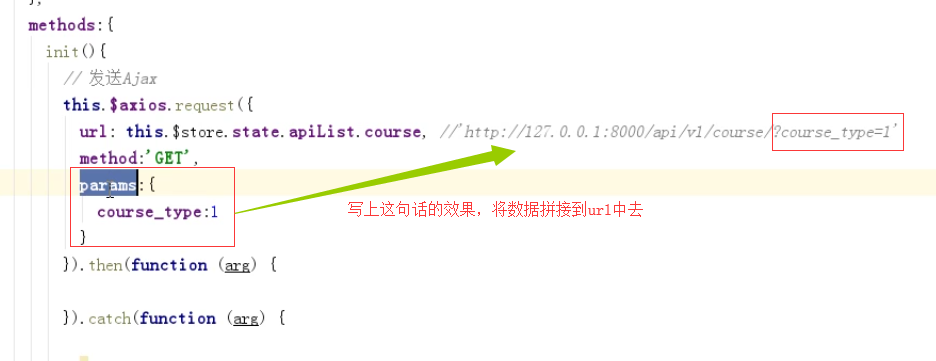
代码

import Vue from 'vue'
import Vuex from 'vuex'
import Cookie from 'vue-cookies'
Vue.use(Vuex)
export default new Vuex.Store({
// 组件中通过 this.$store.state.username 调用
state: {
username: Cookie.get('username'),
token: Cookie.get('token'),
//白名单
apiList: {
auth: 'http://127.0.0.1:8000/api/v1/auth/',
courses: 'http://127.0.0.1:8000/api/v1/courses/',
pricePolicy: 'http://127.0.0.1:8000/api/v1/price_policy/',
shopCar: 'http://127.0.0.1:8000/api/v1/shop_car/',
}
},
mutations: {
// 组件中通过 this.$store.commit('saveToken',{username:'alex',token:'sdfsdfsdf'}) 调用
//这个适用于登陆的,记录用户输入的用户名和生成的token值,并将信息写入到cookie中去
saveToken(state, userToken) {
state.username = userToken.username;
state.token = userToken.token;
Cookie.set("username", userToken.username, "20min")
Cookie.set("token", userToken.token, "20min")
},
//这个是用于注销的,将信cookie中和state中的息全部清除
clearToken(state) {
state.username = undefined
state.token = undefined
Cookie.remove('username')
Cookie.remove('token')
}
}
})
所在目录结构
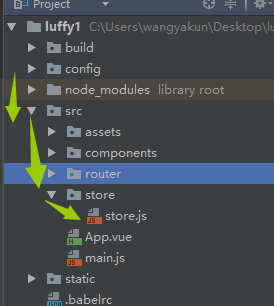
写完store之后在main.js注册上
import Vue from 'vue' import App from './App' import router from './router' import store from './store/store' //这就话相当于给Vue加上一个内部的属性store // 这样就在全局声明了这个内容 Vue.prototype.$store = store Vue.config.productionTip = false /* eslint-disable no-new */ new Vue({ el: '#app', router, //在在这里加上store这样就可以在全局中各个视图组件中使用这个store store, components: { App }, template: '<App/>' })
走完这两部之后就可以在全局中使用store中的属性和方法了
在App.vue中使用
<template> <div> <router-link to="/">首页</router-link> <router-link to="/course">课程</router-link> <router-link to="/micor">学位课</router-link> <router-link to="/news">深科技</router-link> <!--判断当$store中的username的值不是空的时候(默认为空)表示用户已经等路 --> <div v-if="this.$store.state.username"> <a>{{this.$store.state.username}}</a> <a v-on:click="doLogout">注销</a> </div> <!--这里还有一个else方法呢,用于当用户没有登录的情况下--> <div v-else> <router-link to="/login">登录</router-link> </div> <!--<router-link to="/logout">注销</router-link>--> <!--所有路由的出口 点击上边的按钮 就能够显示相应路由的内容--> <router-view/> </div> </template> <script> export default { name: 'App', methods: { doLogout() { // 调用全局store中的方法,执行注销登录的操作 this.$store.commit('clearToken') } } } </script> <style> #app { font-family: 'Avenir', Helvetica, Arial, sans-serif; -webkit-font-smoothing: antialiased; -moz-osx-font-smoothing: grayscale; text-align: center; color: #2c3e50; margin-top: 60px; } </style>
在login.vue中使用
<template> <div> <span>用户名</span> <input type="text" v-model="username" > <span>密码</span> <input type="password" v-model="password"> <button @click="doLogin">提交</button>{{error}} <a>{{username}}</a> </div> <!--<span>{{password}}</span>--> </div> </template> <script> export default { name: 'Login', data() { return { username: '', password: '', error: '', } }, mounted() { }, methods: { doLogin() {
//判断是否用户名密正确,这里使用的是 === 三个等号 if (this.username === 'alex' && this.password === '123') {
//调用store中的一个全局的方法,给用户的cookie中写入内容 this.$store.commit('saveToken',{username:this.username,token:'qwertyui'}) this.$router.push({name: "index"}) } else { this.error = '登录失败' } } } } </script> <style scoped> .img{width:50px;height:50px } </style>
第五步:切换效果
课程详细页面:tab切换 1. HTML <h1>tab切换</h1> <div class="tab-menu"> <div>
//设定点击事件,当被点击的时候,就将这个标签的值设置为ture 详细看下边的方法 <a v-on:click="changeTab('detail')">课程概述</a> <a v-on:click="changeTab('chapter')">课程章节</a> <a v-on:click="changeTab('review')">用户评价</a> <a v-on:click="changeTab('question')">常见问题</a> </div> </div> <div>
//判断变量中的值是true还是false 当是true的时候 显示 false的时候不显示 <div v-show="tabs.detail">课程概述内容</div> <div v-show="tabs.chapter">课程章节内容</div> <div v-show="tabs.review">用户评价内容</div> <div v-show="tabs.question">常见问题内容</div> </div> 2. 变量和函数 export default { name: "detail", data(){ return {
//变量,将一个的值设置为true其他的全部设置为false tabs: { detail: true, chapter: false, //chapter review: false, question: false, }, } }, mounted(){ this.init() }, methods:{
//方法,点击标签触发事件 changeTab(name) { for (let item in this.tabs) { if (item === name) { this.tabs[item] = true } else { this.tabs[item] = false } } } } } 3. 样式 .tab-menu { border-bottom: 1px solid #ddd; padding-top: 30px; text-align: center; } .tab-menu a { display: inline-block; padding: 20px; border-bottom: 2px solid transparent; cursor: pointer; } .tab-menu a:hover { border-bottom: 2px solid darkseagreen; }
第六步:
第七部:基于router的拦截器实现用户登录成功后才能访问页面

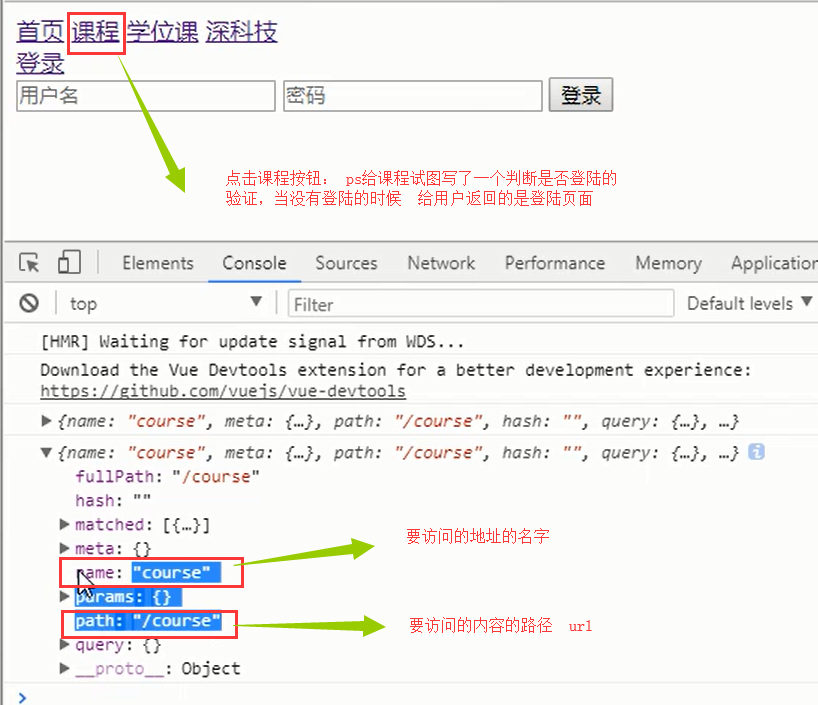
在index.js中设置需要登录和不用登录的url
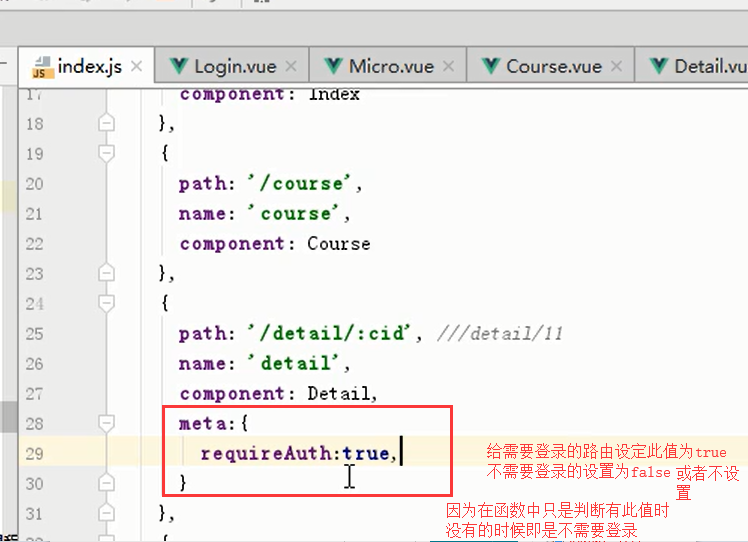
main.js中的代码
// The Vue build version to load with the `import` command // (runtime-only or standalone) has been set in webpack.base.conf with an alias. import Vue from 'vue' import App from './App' import router from './router' import store from './store/store' //这就话相当于给Vue加上一个内部的属性store // 这样就在全局声明这个属性,放到了 $store中了, // 所以可以在内部的视图中使用this.$store来访问store中的内容 Vue.prototype.$store = store Vue.config.productionTip = false /* eslint-disable no-new */ new Vue({ el: '#app', router, //在在这里加上store这样就可以在全局中各个视图组件中使用这个store store, components: { App }, template: '<App/>' })
//这里是进行拦截代码 router.beforeEach(function (to,from,next) { if(to.meta.requireAuth){ // 需要登录的路由 //因为上边有一个import store的过程, // 所以就可以直接试用他。不用写成this.$store if (store.state.token) { // 已经登录,可以去继续访问 next() } else { // 未登录 next({ name: 'login' }) } }else{ // 不需要登录的路由 next() } } )
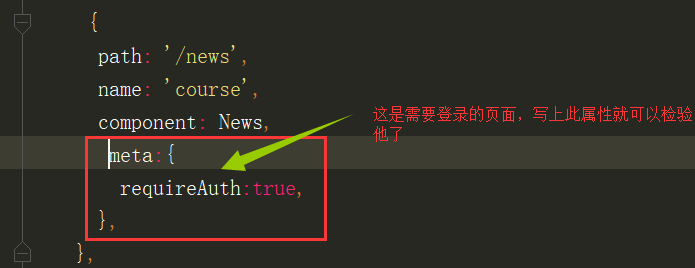
注意this

axios的使用
1先给项目安装依赖

类似于ajax 通过axios 来发送ajax请求
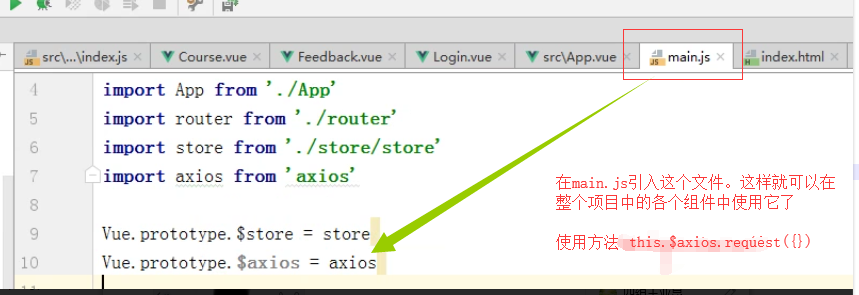
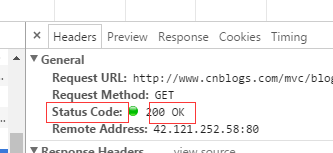
<template> <div> <h1>{{msg}}</h1> <div v-for="item in courseList"> <!--<router-link to="/detail">{{item.id}} {{item.name}} <img class="img" v-bind:src="item.img" alt=""></router-link>--> <!--<router-link :to="{path: '/detail/'+item.id }">{{item.id}} {{item.name}} <img class="img" v-bind:src="item.img" alt=""></router-link>--> <router-link :to="{ name:'detail',params:{cid:item.id} }">{{item.id}} {{item.name}} <img class="img" v-bind:src="item.img" alt=""></router-link> </div> </div> </template> <script> export default { name: "Course", data(){ return { msg:'课程列表', courseList:[], } }, mounted(){ this.init() }, methods:{ init(){ // 发送Ajax var that = this this.$axios.request({ url: this.$store.state.apiList.course, method:'GET', params:{ course_type:1 } #当成功的时候,就返回的数据的status_code为200的时候,数据就存放在then中 类似于ajax中的 success }).then(function (arg) { console.log('then',arg) that.courseList =arg.data.data }).catch(function (arg) { console.log('catch',arg.response) }) } } } </script> <style scoped> .img{ width: 30px; height: 30px; } </style>



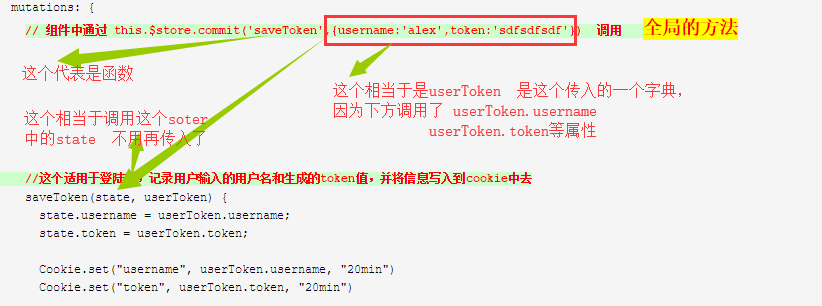



 浙公网安备 33010602011771号
浙公网安备 33010602011771号